Wakefield
OS grid reference:- SE 335 205
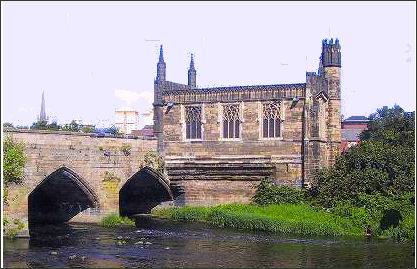 The city of Wakefield is situated on the River Calder and the eastern edge of the Pennine Hills. It lies 9 miles (14 km) to the southeast of Leeds
The city of Wakefield is situated on the River Calder and the eastern edge of the Pennine Hills. It lies 9 miles (14 km) to the southeast of Leeds
Its name is thought to derive from "Waca's field". Other theories suggest it may have developed from the Anglo-Saxon word wacu, meaning "a watch or wake", and feld, an open field in which a wake or festival was held. Wakefield is referred to in the Domesday Book of 1086 as Wachefeld.
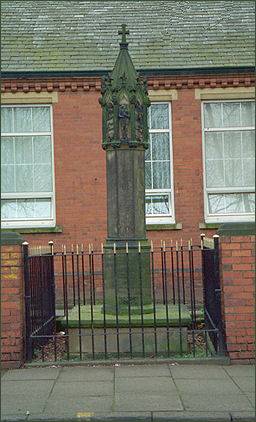 Evidence exists of human habitation in the area since prehistoric times. Flint and stone tools and later bronze and iron implements have been discovered at Lee Moor and Lupset in the Wakefield region. Wakefield developed near a crossing place on the River Calder around three roads, Westgate, Northgate and Kirkgate. The "gate" suffix survives from the Old Norse word gata meaning road.
Evidence exists of human habitation in the area since prehistoric times. Flint and stone tools and later bronze and iron implements have been discovered at Lee Moor and Lupset in the Wakefield region. Wakefield developed near a crossing place on the River Calder around three roads, Westgate, Northgate and Kirkgate. The "gate" suffix survives from the Old Norse word gata meaning road.
Before 1066 the manor of Wakefield was owned by the Anglo-Saxon King Edward the Confessor and following the Battle of Hastings became the property of King William the Conqueror . Wakefield was a victim of William's savage Harrying of the North in 1069 when he took harsh revenge in response to northern rebellions against his rule.The manor was later granted to William de Warenne, 1st Earl of Surrey (died 1088) who was married to the Conqueror's daughter Gundred.
The building of Sandal Castle (left) was commenced in the early twelfth century bby Hamelin Plantagenet, the illegitimate son of Geoffrey of Anjou and half brother of King Henry II. He married the heiress Isabel de Warenne and assumed the Warenne name. The Warenne family held the area until the fourteenth century.
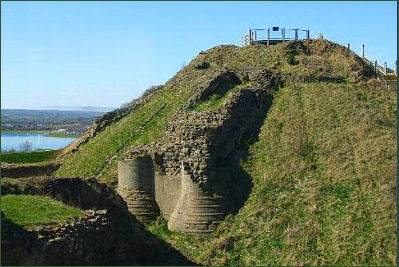 During the Wars of the Roses, Richard Plantagenet, Duke of York, the Yorkist claimant to the throne, met his death along with his seventeen year old second son Edmund, Earl of Rutland, at the hands of a Lancastrian force on 30 December 1460 in the Battle of Wakefield near Sandal Castle. Their heads were later impaled on spikes at York. A memorial commemorates the event (pictured right) at the site where, according to tradition the Duke of York was slain.
The actual site however, may be a little further to the north in Manygates Lane at the junction where the school gates open on to the road. It was once marked by a wooden cross.
During the Wars of the Roses, Richard Plantagenet, Duke of York, the Yorkist claimant to the throne, met his death along with his seventeen year old second son Edmund, Earl of Rutland, at the hands of a Lancastrian force on 30 December 1460 in the Battle of Wakefield near Sandal Castle. Their heads were later impaled on spikes at York. A memorial commemorates the event (pictured right) at the site where, according to tradition the Duke of York was slain.
The actual site however, may be a little further to the north in Manygates Lane at the junction where the school gates open on to the road. It was once marked by a wooden cross.
At the time of the Civil War, Wakefield held out for the Royalist cause. Sir Thomas Fairfax captured the town for the Parliamentarians on 20 May 1643, when the Royalist commander, Lieutenant-General Goring was captured.
The old Wakefield Bridge with its Chantry Chapel, Sandal Castle, and Lawe Hill in Clarence Park- the remains of motte and bailey castle, are monuments of historic interest. The Chantry Chapel of St Mary the Virgin (above left) is richly carved and dates to the mid fourteenth century when the stone bridge was built to replace a wooden one. Its purpose was to provide for a priest to say mass for the souls of the dead to reduce their time in purgatory.
It is one of only three surviving bridge chapels in England. The original stonework is still visible at the base, although the upper part, including the west front, was rebuilt in 1847-8. Recently the interior has undergone restoration with the removal of pew platforms, a new stone floor and new seating. The Chantry is now under the authority of the Dean and Chapter of Wakefield Cathedral.
Another structure of interest in the city is the 95-arch railway viaduct, constructed of 800,000,000 bricks in the 1860s on the Doncaster to Leeds railway line. Wakefield Museum, situated in Wood Street is fully interactive and an interesting place for families to visit.
The Theatre Royal Wakefield on Westgate was designed by architect Frank Matcham and opened in 1894 and currently presents a programme of entertainment including musicals, drama, live music, stand up comedy and dance.
The Hepworth Wakefield gallery opened on the south bank of the River Calder near Wakefield Bridge in May 2011. The gallery displays work by local artists Barbara Hepworth and Henry Moore and other British and international artists. The gallery is thought to be the largest purpose-built gallery to open in Britain since 1968.
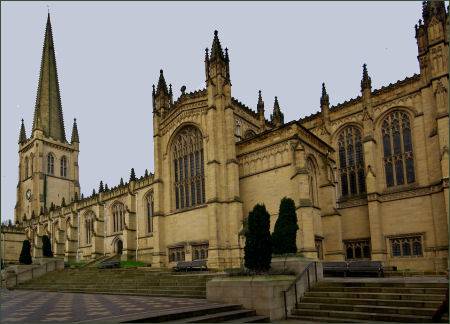
The Yorkshire Sculpture Park is set in 500 acres of parkland where visitors can view the landscape that inspired locally born artists Henry Moore and Barbara Hepworth.
Wakefield CathedralWakefield Cathedral, or the Cathedral Church of All Saints was originally the city's parish church and is set at the heart of Wakefield on a hill on Kirkgate. It is one of Yorkshire's greatest churches.
The building has Anglo Saxon origins and boasts the tallest spire in Yorkshire, which rises to 247 feet (75 metres) and dominates the city skyline. The Norman church which replaced the original Saxon building was rebuilt again in 1329, and apart from the tower and spire, it was rebuilt and enlarged in 1469.
The church was reconstructed and altered at various times and its spire, which was damaged in a violent gale, was renewed in 1823.
Before the sixteenth century the church was known by its Anglo Saxon name of All Hallows, but following the Reformation its name was changed to All Saints. It was largely rebuilt in the Perpendicular Gothic style in the early fifteenth century and, after years of neglect in the eighteenth century, was restored in Victorian times by Sir George Gilbert Scott and his son John Oldrid Scott.
The cathedral contains a complete set of fifteenth century ceilings throughout the Nave, aisles and east end. These have an excellent collection of carved bosses depicting a wide range of themes. The nave clerestory has finely carved capitals including one of a wild boar eating acorns.
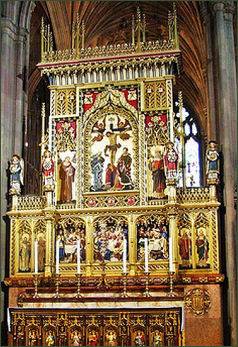 None of the medieval stained glass survives in the cathedral, most of the its glass is the work of the Victorian artist Charles Eamer Kempe.
None of the medieval stained glass survives in the cathedral, most of the its glass is the work of the Victorian artist Charles Eamer Kempe.
The rood screen dates back to the seventeenth century and above it is a rood by Ninian Comper which was completed in 1950.
The quire screen was carved by Thomas Grundy of Leeds in 1636. The unusual octagonal font dates to the mid seventeenth century and the pulpit from 1708.
Eleven of the fifteenth century choir stalls, have misericords and other carvings including a green man and mythical beasts, these were the gift of Sir Thomas Savile in 1482 to celebrate his marriage to Margaret Bosworth
The reredos, which is considered to be one of the finest Victorian examples in England, is the work of John Oldrid Scott, who also added the organ chamber and vestries. Some of the furniture in St Mark's Chapel is by Robert Thompson, the 'Mouseman' of Kilburn,whose trademark was a carved mouse.
The parish church was raised to Cathedral status in 1888.
The Chantry Chapel of St Mary the Virgin at Wakefield
Towns and Villages of Yorkshire
